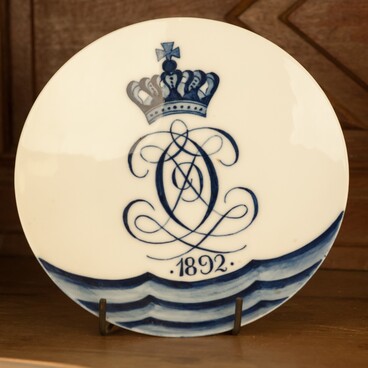The production of same-style dinner services began in the 18th century Western Europe. The development of dining etiquette contributed to the diversity of tableware. Gradually, a tureen appeared among serving vessels. First porcelain tureens appeared in France in the 17th-18th centuries, a testimony to the wealth and exquisite taste of their owners. Since the second half of the 19th century tureens were in use worldwide, and in Russia as well. Manufacturers of porcelain tableware, including M.S. Kuznetsov Partnership Manufacture of Porcelain and Faience in Dulyovo routinely added tureens to their dinner services.
A cover was required to fit closely to the bowl in order not to release the heat. The dinner service that is now on display in the State Dining Room of Massandra palace, was purchased from a private owner in 1995. It consists of 65 items, including this tureen.
The factory in Dulyovo reached the peak of its development under a talented industrialist Matvey Kuznetsov. His talent for pottery was probably due to the fact that all his ancestors were from Gzhel, a renowned center of traditional blue-and-white ceramics production. The dynasty of porcelain industrialists was founded by his great-grandfather, Yakov Kuznetsov. It was Matvey Kuznetsov who provided all the departments of the factory with modern equipment which he had brought from France. The factory produced both elegant dinner sets for the court and affordable tableware. All the porcelain items were decorated, which greatly contributed to the popularity of the factory. Altogether, Kuznetsov factories employed 1300 full-time workers and 4000 part-time workers. Kuznetsov had his wares in 10 major cities of Russia. Items produced by the ‘Kuznetsov Porcelain Empire’ was top-quality and was awarded with Gold medals at the Fairs in Paris and Tashkent. Porcelain and faience tableware were in high demand not only in Russia, but also in Turkey, Persia (modern-day Iran), Bulgaria, Japan, United States, Austria, India, etc. The production of the giant company was intended for different social segments: rich peasants, bourgeois, merchants. By the end of the 19th century the ‘Kuznetsov Porcelain Empire’ accounted for 75% of all the income of all the porcelain-faience production in the Russian Empire.
In 1902 Matvey Kuznetsov was included in the honorary list of the Suppliers of the Court of His Imperial Majesty. The porcelain empire provided scholarships for the Stroganov Art School and the Artists Society. The production embraced all the newest technologies with lightning speed, which allowed the factory in Dulyovo to become the leader among all the porcelain production manufactures in the late 19th – early 20th centuries.
The production range of the Kuznetsov porcelain factory was extremely diverse, and the variety of dinner services produced was enough to satisfy any taste. The whiteness of the porcelain was ensured by the use of high-quality raw material, good processing of the ceramic mass, and its lengthy, for up to a year long, maturing in the cellars of the blank preparation shop. The quality of the porcelain was also achieved by top-class qualification of the workers.
A cover was required to fit closely to the bowl in order not to release the heat. The dinner service that is now on display in the State Dining Room of Massandra palace, was purchased from a private owner in 1995. It consists of 65 items, including this tureen.
The factory in Dulyovo reached the peak of its development under a talented industrialist Matvey Kuznetsov. His talent for pottery was probably due to the fact that all his ancestors were from Gzhel, a renowned center of traditional blue-and-white ceramics production. The dynasty of porcelain industrialists was founded by his great-grandfather, Yakov Kuznetsov. It was Matvey Kuznetsov who provided all the departments of the factory with modern equipment which he had brought from France. The factory produced both elegant dinner sets for the court and affordable tableware. All the porcelain items were decorated, which greatly contributed to the popularity of the factory. Altogether, Kuznetsov factories employed 1300 full-time workers and 4000 part-time workers. Kuznetsov had his wares in 10 major cities of Russia. Items produced by the ‘Kuznetsov Porcelain Empire’ was top-quality and was awarded with Gold medals at the Fairs in Paris and Tashkent. Porcelain and faience tableware were in high demand not only in Russia, but also in Turkey, Persia (modern-day Iran), Bulgaria, Japan, United States, Austria, India, etc. The production of the giant company was intended for different social segments: rich peasants, bourgeois, merchants. By the end of the 19th century the ‘Kuznetsov Porcelain Empire’ accounted for 75% of all the income of all the porcelain-faience production in the Russian Empire.
In 1902 Matvey Kuznetsov was included in the honorary list of the Suppliers of the Court of His Imperial Majesty. The porcelain empire provided scholarships for the Stroganov Art School and the Artists Society. The production embraced all the newest technologies with lightning speed, which allowed the factory in Dulyovo to become the leader among all the porcelain production manufactures in the late 19th – early 20th centuries.
The production range of the Kuznetsov porcelain factory was extremely diverse, and the variety of dinner services produced was enough to satisfy any taste. The whiteness of the porcelain was ensured by the use of high-quality raw material, good processing of the ceramic mass, and its lengthy, for up to a year long, maturing in the cellars of the blank preparation shop. The quality of the porcelain was also achieved by top-class qualification of the workers.



